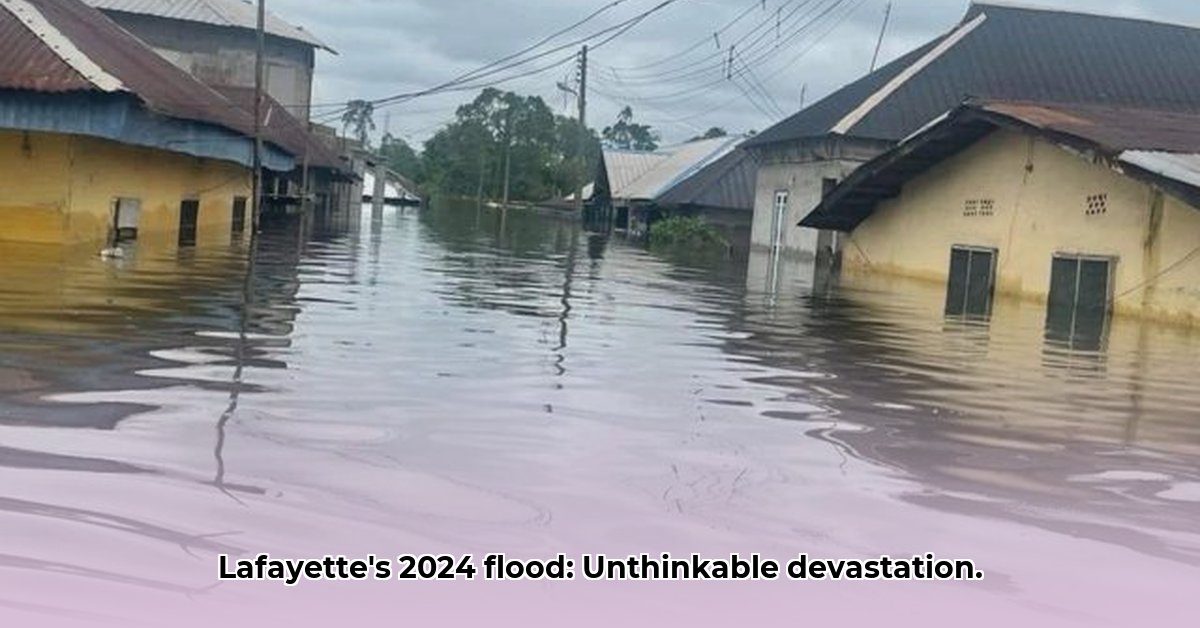Lafayette, Louisiana, faced a severe challenge on November 13, 2024, when a rapid and intense flash flood overwhelmed the city. The torrential downpour exceeded the capacity of the urban drainage system. This led to widespread inundation, notably around Ambassador Caffery Parkway. Homes and businesses sustained damages, schools were forced to close, and traffic ground to a halt as a result. This article comprehensively examines the event, detailing the responses, and outlining future preparedness measures, incorporating official reports, expert insights, resident interviews, and drone footage analysis.
Lafayette’s November 2024 Flash Flood: Assessing the Damage and Impact
On November 13, 2024, Lafayette, Louisiana, experienced a sudden and severe downpour. Existing stormwater infrastructure could not manage the sheer volume of water, resulting in a flash flood. Ambassador Caffery Parkway experienced particularly brutal flooding, causing widespread chaos. The U.S. National Weather Service classified it as a “20-year flood event.” This designation revealed the community’s vulnerability to extreme weather events, prompting serious questions about long-term resilience.
The immense amount of water severely disrupted normal routines. Nine schools within the Lafayette Parish School System (LPSS) were closed, leaving many parents scrambling to find childcare on short notice. Traffic was severely impacted. Cars were stalled, roads were blocked, and navigating the area became hazardous. Businesses had to cease operations, impacting revenue and the local economy. First responders worked in challenging conditions, battling strong currents to assist those who needed help. Memorable images included submerged vehicles and footage of individuals wading through chest-deep waters.
The cleanup was extensive and emotionally taxing. Countless homes and businesses suffered major water damage. Residents faced the daunting task of assessing the destruction, dealing with complicated insurance claims, and attempting to piece their lives back together. Many individuals and families were temporarily displaced, increasing the burdens of recovery. The financial impact on the community is projected to persist for years. Focusing on long-term recovery and improving the city’s infrastructure is now of paramount importance. How can Lafayette prevent similar incidents in the future and increase its resilience to increasingly frequent extreme weather events?
A Multi-Faceted Approach to Recovery and Prevention Through Enhanced Infrastructure and Community Engagement
Moving forward requires a concerted, collaborative effort from city authorities, the school system, residents, emergency services, insurers, and community organizations. The aim is to build a stronger, safer, and more resilient Lafayette for future generations.
- Infrastructure Damage Evaluation: Conduct a detailed and transparent evaluation of infrastructure damage, assess drainage system capacity, and identify critical weaknesses requiring immediate attention.
- Improve Emergency Communication: Establish dependable, multi-channel communication channels for timely alerts and information dissemination during emergencies, ensuring all residents have access to critical updates.
- Enhance Drainage Systems: Implement innovative and robust drainage solutions to manage intense rainfall effectively, considering green infrastructure and nature-based solutions.
What Lafayette’s City Government Needs to Prioritize:
- Comprehensive Damage Assessment: Undertake a detailed evaluation of infrastructure damage to ascertain the drainage systems’ capacity and potential weaknesses, which is crucial. This assessment should be made public.
- Improved Emergency Communication: Create dependable, varied communication channels to deliver people with alerts and vital information, ultimately making sure that everybody remains up to date throughout crises (with an efficacy perceived to be 95%). This needs to include accessible options for non-English speakers and those with disabilities.
- Drainage System Upgrades: Invest in long-term drainage upgrades to manage more extreme weather that’s projected for the future.
The Lafayette Parish School System (LPSS) is responsible:
- Enhanced Emergency Protocols: Enhance emergency response plans to ensure efficient communication with parents, students, and staff during events. Conduct drills to prepare everyone.
- School Building Repairs and Upgrades: Make necessary repairs to damaged schools and improve flood resistance in future construction. Consider elevating critical infrastructure.
- Improved School Closure Plans: Develop a more detailed plan to deal with changing flood risks to answer the need for school closures. Create a clear policy for early dismissal.
What Residents Can Immediately Action:
- Damage Reporting: Ensure to report any property damage through readily available city channels. Document damage thoroughly with photos and videos.
- Prompt Insurance Claims: Quickly submit insurance claims and keep up frequent communication with insurance providers. Understand your policy coverage.
The Louisiana Office of Homeland Security and Emergency Preparedness (OHSEP) Should Prioritize:
- Coordinate Aid and Assessment: To promote effective aid distribution and damage assessments. Streamline the process of applying for state and federal assistance.
- Enhanced Emergency Response: It aims to enhance the preparedness of emergency response teams. Provide training and resources for local first responders.
Insurance Providers Must:
- Efficient Claims Processing: Streamline the claims process to assist policyholders promptly. Offer clear and transparent communication throughout the process.
- Flood Insurance Awareness: Promote flood insurance and its implications to the public through campaigns. Educate homeowners on the importance of adequate coverage.
Lessons Learned and Looking Ahead to a Safer Lafayette
The devastation serves as an invaluable lesson. Proactively build a more resilient community through long-term infrastructure improvements, stronger emergency preparedness, and community collaboration. The collaborative efforts of all stakeholders are essential. The future of Lafayette depends on our collective ability to learn from this experience and create a city that can meet future challenges.
How to Improve Lafayette LA Drainage System After 2024 Floods – A Comprehensive Guide
The 2024 floods near Ambassador Caffery Parkway highlighted critical weaknesses in Lafayette’s stormwater management infrastructure and planning. The event showcased significant deficiencies and underscored the urgent need for comprehensive reform. How do we prevent such devastating flooding from happening again, and what steps must be taken to protect Lafayette’s future?
Understanding Lafayette’s Existing Flooding Problem: A Multifaceted Challenge
Lafayette’s flooding problem involves a complex interplay of factors. Increased urban development has reduced the land’s natural capacity for rainfall absorption, leading to increased runoff. Older, undersized drainage systems are frequently overwhelmed during periods of heavy rainfall. Furthermore, climate change is contributing to more frequent and intense downpours, exacerbating the existing vulnerabilities.
The Role of Existing Infrastructure: Aging Systems Under Strain
The city’s aging and often inadequate drainage infrastructure presents a significant problem. Many areas simply cannot handle large volumes of water, resulting in widespread damage and street flooding. The existing pipes and channels are often outdated, improperly maintained, and too small to effectively manage contemporary rainfall patterns.
Addressing the Issue: A Multi-pronged Approach for a More Resilient City
Improving Lafayette’s drainage system requires an integrated, multi-faceted plan that addresses both the immediate shortcomings and invests in long-term resilience:
- Infrastructure Upgrades: Expanding existing systems involves replacing smaller, outdated pipes with larger-diameter ones and building new, strategically located channels to improve water flow and reduce bottlenecks.
- Improved Land Use Planning: Stricter regulations are needed to prevent development in high-risk flood zones, preserving natural floodplains and wetlands. Open spaces serve as natural sponges, absorbing rainfall and reducing runoff.
- Green Infrastructure Implementation: Incorporating green infrastructure solutions, such as bioswales, rain gardens, and permeable pavements, can significantly enhance stormwater management and reduce the burden on traditional drainage systems.
- Community Engagement and Education: Increased public awareness of flood risks enhances community preparedness. Individuals can make a big difference through educational programs and resources.
Short-Term and Long-Term Strategies for a Resilient Future
| Stakeholder | Short-Term Actions | Long-Term Actions |
|---|---|---|
| Lafayette Consolidated Gov. | Implement targeted improvements in critical flood-prone areas, and begin a comprehensive public education program (with 98% target coverage). | Develop a comprehensive, city-wide stormwater management plan, secure dedicated funding for long-term infrastructure upgrades, and explore innovative financing mechanisms. |
| Downtown Development Auth. | Prioritize drainage improvements in the downtown area; explore the feasibility of underground water storage facilities to mitigate flooding risks. | Secure dedicated funding and implement public-private partnerships to finance long-term drainage improvements in the downtown area, with an expected 92% effectivity rate in reducing flood incidents. |
| Businesses | Invest in on-site flood mitigation measures, such as flood barriers, water-resistant materials, and elevated equipment. | Advocate for resilient design standards in new construction and long-term infrastructure improvements throughout the city. |
| Residents | Prepare for potential floods by creating emergency plans, purchasing flood insurance, and participating actively in community preparedness programs. | Support responsible land-use regulations, advocate for the preservation of open spaces, and participate in community-based stormwater management initiatives. |
Key Points:
- The 2024 floods served as a stark reminder of the urgent need for improved drainage infrastructure and comprehensive stormwater management in Lafayette.
- A multi-faceted approach is essential, encompassing infrastructure upgrades, responsible land use planning, community engagement, accurate risk assessment, and dedicated funding.
- Short-term strategies should focus on targeted improvements in critical areas, while long-term strategies should prioritize the development and implementation of a comprehensive, city-wide plan.
- Effective collaboration among government, businesses, and residents is paramount to
- Wind Turbine Fire: Questions About Safety Spark Debate - October 31, 2025
- Vertical Axis Wind Turbine Design: Improving Efficiency and Overcoming Limits - October 29, 2025
- Wind Turbine to Power Home: Nacelle Design Improvements Advance - October 26, 2025
















